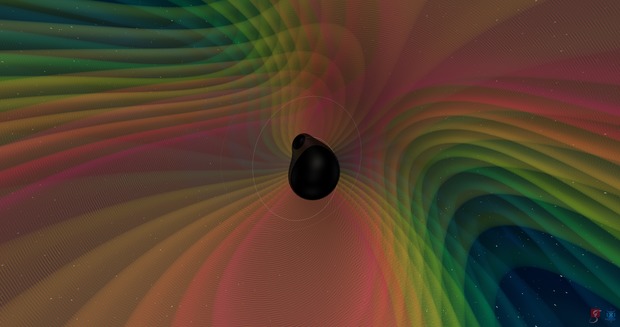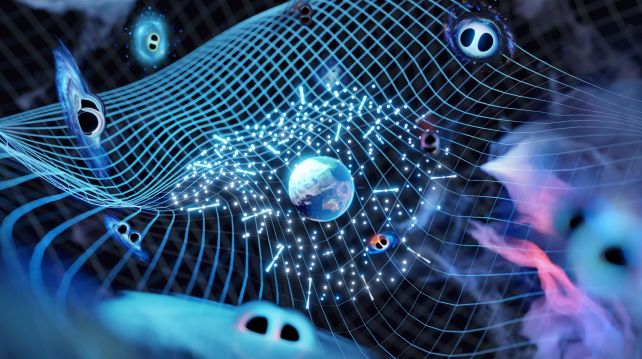
It’s official. There is something out there shaking the stars in a way that can no longer be attributed to chance.
Several teams around the world have independently found a signal in the time of flickering stars called pulsars that points to giant, long-wavelength gravitational waves rolling through the galaxy. It’s not a detection of these gravitational waves yet, but there’s more than a 99 percent chance that what we’re seeing is something significant.
Teams from Australia, the US, Europe, China and India publish their results simultaneously in multiple papers.
“We’ve been on a mission for the last 15 years to find a low hum of gravitational waves that resonate throughout the Universe and travel through our galaxy to warp space-time in a measurable way,” said the ‘astrophysicist Stephen Taylor of Vanderbilt University and the president of NANOGrav, the US team, said at a press conference.
“We are very pleased to announce that our hard work has paid off and … we have exciting evidence of this gravitational wave background.”
Gravitational wave astronomy is a relatively new field, following the detection of spacetime waves caused by two colliding black holes in 2015. Since then, our gravitational wave detectors based on Earth has detected nearly 100 confirmed gravitational wave events at the time of this event. writing, all created by mergers of compact objects of stellar mass: black holes and neutron stars.
A numerical simulation of a binary black hole merger and the gravitational waves generated. (N. Fischer, H. Pfeiffer, A. Buonanno (Max Planck Institute for Gravitational Physics), Simulating eXtreme Spacetimes (SXS) Collaboration)
Gravitational waves are caused by massive events in the Universe. Imagine a collision between black holes like a rock thrown into a pond and gravitational waves as the ripples were generated. The medium is space-time itself, and the ripples, traveling at the speed of light, propagate in all directions, stretching and compressing space-time in ways we can detect. We’ve explained all the background in more detail here if you want to dig deeper.
Now imagine how many black holes must be colliding in the Universe. And how many other massive events must be generating these ripples. Spacetime should absolutely be singing gravitational waves, but there’s a problem. Earth is simply too small to detect them at the longer wavelengths on the nanohertz scale that can extend for light years, the ones expected from more massive events, such as the mergers of supermassive black holes in the center of galaxies.
Luckily, however, we live in a galaxy much larger than Earth. And there is something in our galaxy that emits very precisely timed signals that can be affected by nanohertz gravitational waves: radio pulsars. These are extremely fast-spinning neutron stars, with jets of radio light emanating from their magnetic poles. As they spin, these rays sweep across Earth like a cosmic beacon, and because the timing of these pulses is so precise, we can use them to detect the way space stretches and contracts as that gravitational waves circulate.
A small error in timing is not enough. But if you have enough pulsars with correlated errors over a long enough period of time, you can collect evidence of a large gravitational wave. That’s what different teams from around the world did, studying a total of 115 pulsars between them, for up to 18 years for Australia’s Parkes Pulsar Timing Array.
the traversing gravitational wave (in this animation it’s coming straight through the computer screen at you) will warp the particle circle in a characteristic way. (People in the know will know that this is only one possible pattern: linear polarization.) 5/ pic.twitter.com/8FFJa97r3a
— Markus Pössel (@mpoessel) June 25, 2023
“A Pulsar Timing Array is a galactic-scale detector of gravitational waves. We detected a common ‘buzz’ among the pulsars in our array: a signal at very low frequencies,” explains PPTA astrophysicist Daniel Reardon and Swinburne University in Australia. ScienceAlert.
“We, along with our international colleagues, are also seeing an indication of the fingerprint that identifies this noise as originating from gravitational waves.”
We’ve had hints of this signal before. In January 2021, NANOGrav published a paper detailing what they thought was the first hint of the gravitational wave background in their pulsar timing data. In January 2022, the International Pulsar Timing Array followed suit with its suite of pulsars.
Now, after painstaking work to determine that the signal was not generated by pulsars or other noise in the data, the researchers have concluded that the signal is significant.
The NANOGrav signal has a confidence level of 4 sigma in 67 pulsars, or 99.349 percent. The PPTA signal has a lower confidence level because it studied fewer pulsars; its detection is based on only 30 stars, but over a longer period. The gold standard for a discovery is 5 sigma. So there is still a lot of work to be done.
 A display of a pulsar timing matrix. (OzGrav)
A display of a pulsar timing matrix. (OzGrav)
“This is not yet a detection of gravitational waves,” says Reardon. “This fingerprint will have to be made clearer, for example using more data, to confirm this as a detection of gravitational waves. But this is very exciting, though, because the fingerprint was expected to emerge slowly in our data sets, as it appears to be. doing so with the observed evidence from the Collaborative Collection of Pulsar Timing Arrays.”
Since this is not yet a confirmed detection of gravitational waves, researchers cannot say conclusively what causes it. The most obvious answer is supermassive black holes. Supermassive black hole mergers should occur at a rate that fills the Universe with the sound of gravitational waves, like the roar of the sea.
It is not the only potential source of the gravitational wave background. Cosmic strings, phase changes in the Universe, the rapid inflation of space that followed the Big Bang—all of these could produce low-frequency gravitational waves. (The Big Bang may have too, but the wavelength would be the size of the Universe, something we definitely don’t have a big enough detector for.)
What we’re probably looking at right now is the bottom of the supermassive black hole.
“We know that every large galaxy has a supermassive black hole at its core. We also know that galaxies collide, and when they do, we expect the supermassive black holes to collapse into the center and start spinning around each other. other, emitting gravitational waves,” explains Reardon.
“The farther we look into the Universe, the more of these supermassive black hole systems we can see. A very large population of orbiting supermassive black holes in the distant Universe creates a random ocean of gravitational waves that sweep over Earth and Earth’s pulsars. our galaxy.”
Pulsar timing array astronomy is a long game, but we are close to the confirmed signal. Separate pulsar timing arrays from around the world have now combined their datasets and are working to corroborate their findings under the IPTA collaboration. That confirmation should come in a year, maybe two at a time.
frameborder=”0″ allow=”accelerometer; automatic playback; clipboard-writing; encrypted media; gyroscope; picture in picture; web-share” allows full screen>
Then, a bold new era of nanohertz gravitational wave astronomy may begin. Researchers will be able to separate the signal, study its characteristics, and figure out the sources of the massive gravitational disruptions that are booming in space. From there, we can even begin to investigate, in more detail than ever before, the properties of supermassive black holes.
“This pulsar timing array work is the first indication of nanohertz frequency gravitational waves,” Reardon tells ScienceAlert.
“Imagining that the Universe is really a rumbling ocean of stretching and contracting space is incredible. Supermassive black holes are cosmic giants at the heart of galaxies that feed on gas and disrupt star formation. I’m excited for a future where our observations of pulsars reveal a complex map of gravitational waves rippling from pairs of supermassive black holes We should see the background hum of the Universe with gravitational wave ‘hotspots’ of individual pairs of supermassive black holes located in galaxies that we can identify.”
PPTA papers will be published in The Astrophysical Journal Letters and Publications of the Astronomical Society of Australia. All five NANOGrav papers will appear in The Astrophysical Journal Letters. The Chinese Pulsar Timing Array work appears in Research in Astronomy and Astrophysics.
We will add links to more articles as they become available.
[ad_2]
Source link





